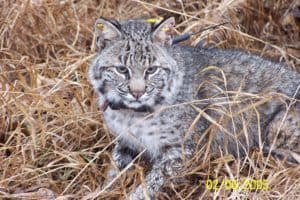Share this article
JWM: Bobcats recolonize Iowa, but farms remain obstacles
Bobcats are steadily recolonizing the southern third of Iowa after being extirpated from the state for decades, according to new research.
“It highlights that bobcats are highly adaptable,” said Dawn Reding, an associate professor of biology at Luther College and the co-author of a study published recently in the Journal of Wildlife Management.
Bobcats were extirpated from the state by the 1970s due to historical overharvesting and habitat loss to agriculture, persecution and lax regulations, Reding said. But people began to report sightings of the felines in the late 1990s and early 2000s, and the evidence of their recolonization slowly started to mount.
Reding and her co-authors have been working on understanding how well the species is recolonizing in the state. They had a huge number of animals to work with partly thanks to trappers in the area. When trappers caught bobcats, they were required to report them to conservation officers and biologists because it was illegal to harvest the species in the state at the time of the study. Reding said that researchers jumped on these opportunities and equipped the trapped animals with radio collars before they were released.
For this study, the researchers looked at how far juveniles were dispersing after they left their natal range during their first two years to find new territory.

Study authors said that better cooperation between states would help regional bobcat management. ©Iowa State University
The researchers looked at dispersal data gathered from 61 bobcats equipped with radio collars in the first two years of their lives between 2003 and 2009 in southcentral Iowa, where the heaviest populations of the predators are found.
They found that 65% of the males in the study dispersed from their natal range, while 26% of the females left. The females tended not to go too far while the males made longer trips to find a new home territory. One male ended up over 125 miles away.
Reding said it surprised her that the bobcats did so well in the area. “We’re in a pretty agriculturally fragmented landscapes. There’s not as much forest and grassland as would be ideal for bobcats,” she said.
At least in the southern and central parts of the state, the cats could maneuver through this. But to the north, where there’s more agriculture, it isn’t quite so hospitable for the felines. Reding said that most of the dispersals that happened from cats in southcentral Iowa went east, west or south. Only one male went northward, but then ended up turning around and heading all the way to Missouri.
“We saw bobcats can move some pretty long distances, and they obviously don’t obey state boundaries,” Reding said.
This highlights one of the challenges for bobcat management in general, she said. Many states surrounding Iowa have different rules on harvesting. High harvests in neighboring states can affect dispersal distance and might slow their recolonization in Iowa.
As a result, Reding said, states should work together more to take a regional view on bobcat conservation and management.
This article features research that was published in a TWS peer-reviewed journal. Individual online access to all TWS journal articles is a benefit of membership. Join TWS now to read the latest in wildlife research.
Header Image: Bobcats have been recolonizing southern Iowa after being extirpated from the state several decades ago. ©Iowa State University








